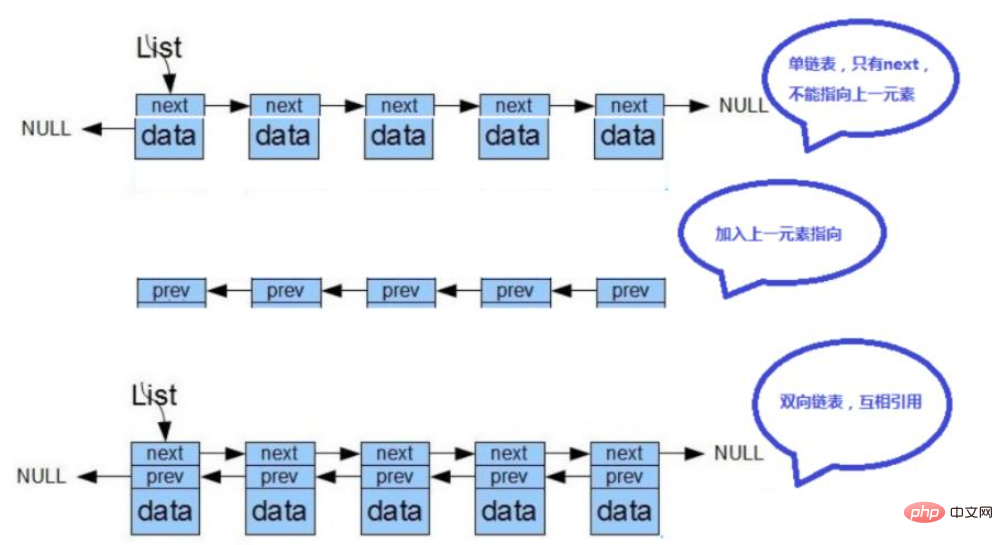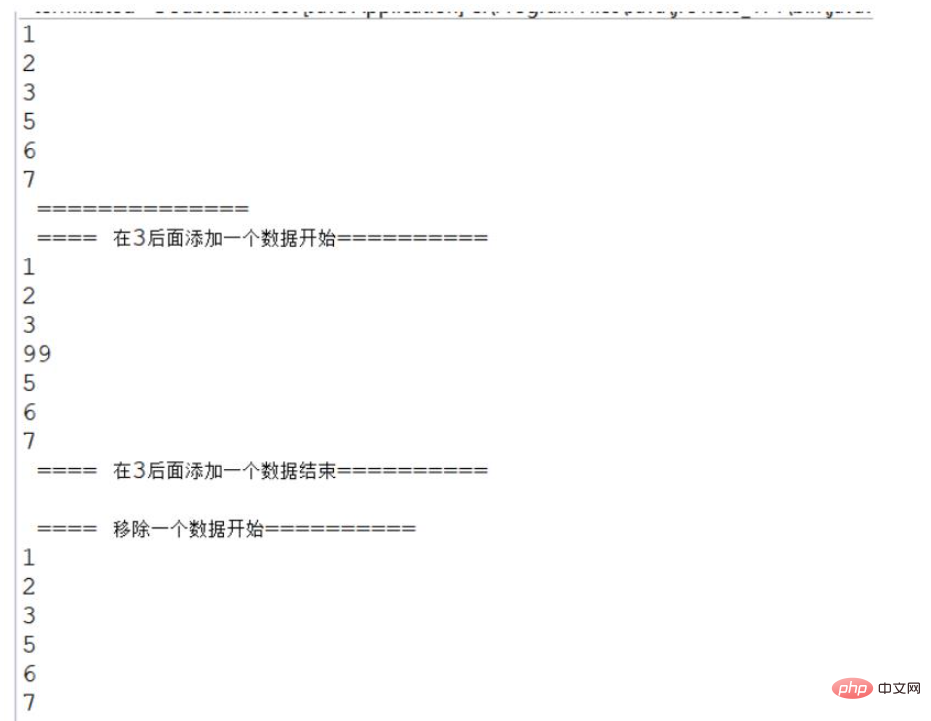Java simulation method to implement doubly linked list
Doubly linked list Also called a doubly linked list, it is a type of linked list. Each of its data nodes has two pointers, pointing to the direct successor and direct predecessor respectively. Therefore, starting from any node in the doubly linked list, you can easily access its predecessor node and successor node
The following figure is two-way The logical structure diagram of a linked list is different from a singly linked list in that each node in a doubly linked list contains pointer references to two nodes and a data field. These two nodes point to the previous node and the next node respectively;
This structure of a doubly linked list is improved compared to a singly linked list. By referencing the front and rear nodes, the entire linked list can be traversed forward or backward with a given value, which is greatly improved. The efficiency of traversal query solves the performance problem of singly linked list to a certain extent, but at the same time, the storage overhead of linked list also increases. The bottom layer of the familiar linkedList is implemented by this principle.

Without further ado, I believe everyone has understood it clearly through the above explanation. Let’s go directly to the code. You can understand the doubly linked list by combining the code and graph structure.
public class DoubleLinkTest<T> {
/**
* 内部构造节点类
*
* @param <T>
*/
private class Node<T> {
private T data;
private Node next; // 指向下一个节点的引用
private Node prev; // 指向前一个节点的引用
public Node(T data) {
this.data = data;
}
}
private Node<T> head; // 模拟头结点
private Node<T> last; // 模拟尾部节点
private Node<T> other; // 暂定一个临时节点,用作指针节点
private int length;
public void DoubleLinkTest() {
head = new Node<T>(null);
last = head;
length = 0;
}
public void DoubleLinkTest(T data) {
head = new Node<T>(data);
last = head;
length = 0;
}
/**
* 链表是否为空
*
* @return
*/
public boolean isEmpty() {
return length == 0;
}
/**
* 普通添加,往链表尾部添加
*
* @param data
*/
public void add(T data) {
if (isEmpty()) { // 链表为空,新创建一个链表
head = new Node<T>(data);
last = head;
length++;
} else {
other = new Node<T>(data);
other.prev = last;
last.next = other; // 将新的节点与原来的尾部节点进行结构上的关联
last = other; // other将成为最后一个节点
length++;
}
}
/**
* 在指定的数据后面添加数据
*
* @param data
* @param insertData
*/
public void addAfter(T data, T insertData) {
other = head;
while (other != null) { // 我们假定这个head是不为空的。
if (other.data.equals(data)) {
Node<T> t = new Node<T>(insertData);
t.prev = other;
t.next = other.next;// 对新插入的数据进行一个指向的定义
other.next = t;
if (t.next == null) {
last = t;
}
length++;
}
other = other.next;
}
}
/**
* 删除,删除指定的数据
*
* @param data
*/
public void remove(T data) {
other = head;// 我们假定这个head是不为空的。
while (other != null) {
if (other.data.equals(data)) {
other.prev.next = other.next;
length--;
}
other = other.next;
}
}
/**
* 测试打印数据
*/
public void printList() {
other = head;
for (int i = 0; i < length; i++) {
System.out.println(other.data + " ");
other = other.next;
}
}
public static void main(String[] args) {
DoubleLinkTest<Integer> link = new DoubleLinkTest<Integer>();
link.add(1);
link.add(2);
link.add(3);
link.add(5);
link.add(6);
link.add(7);
link.printList();
System.out.println(" ============== ");
System.out.println(" ==== 在3后面添加一个数据开始========== ");
link.addAfter(3, 99);
link.printList();
System.out.println(" ==== 在3后面添加一个数据结束========== " + "\r\n");
System.out.println(" ==== 移除一个数据开始========== ");
link.remove(99);
link.printList();
System.out.println(" \r\n");
}
}Run the main function, You can see the console printout:

The above is the detailed content of Java simulation method to implement doubly linked list. For more information, please follow other related articles on the PHP Chinese website!

Hot AI Tools

Undresser.AI Undress
AI-powered app for creating realistic nude photos

AI Clothes Remover
Online AI tool for removing clothes from photos.

Undress AI Tool
Undress images for free

Clothoff.io
AI clothes remover

Video Face Swap
Swap faces in any video effortlessly with our completely free AI face swap tool!

Hot Article

Hot Tools

Notepad++7.3.1
Easy-to-use and free code editor

SublimeText3 Chinese version
Chinese version, very easy to use

Zend Studio 13.0.1
Powerful PHP integrated development environment

Dreamweaver CS6
Visual web development tools

SublimeText3 Mac version
God-level code editing software (SublimeText3)

Hot Topics
 1386
1386
 52
52
 Perfect Number in Java
Aug 30, 2024 pm 04:28 PM
Perfect Number in Java
Aug 30, 2024 pm 04:28 PM
Guide to Perfect Number in Java. Here we discuss the Definition, How to check Perfect number in Java?, examples with code implementation.
 Weka in Java
Aug 30, 2024 pm 04:28 PM
Weka in Java
Aug 30, 2024 pm 04:28 PM
Guide to Weka in Java. Here we discuss the Introduction, how to use weka java, the type of platform, and advantages with examples.
 Smith Number in Java
Aug 30, 2024 pm 04:28 PM
Smith Number in Java
Aug 30, 2024 pm 04:28 PM
Guide to Smith Number in Java. Here we discuss the Definition, How to check smith number in Java? example with code implementation.
 Java Spring Interview Questions
Aug 30, 2024 pm 04:29 PM
Java Spring Interview Questions
Aug 30, 2024 pm 04:29 PM
In this article, we have kept the most asked Java Spring Interview Questions with their detailed answers. So that you can crack the interview.
 Break or return from Java 8 stream forEach?
Feb 07, 2025 pm 12:09 PM
Break or return from Java 8 stream forEach?
Feb 07, 2025 pm 12:09 PM
Java 8 introduces the Stream API, providing a powerful and expressive way to process data collections. However, a common question when using Stream is: How to break or return from a forEach operation? Traditional loops allow for early interruption or return, but Stream's forEach method does not directly support this method. This article will explain the reasons and explore alternative methods for implementing premature termination in Stream processing systems. Further reading: Java Stream API improvements Understand Stream forEach The forEach method is a terminal operation that performs one operation on each element in the Stream. Its design intention is
 TimeStamp to Date in Java
Aug 30, 2024 pm 04:28 PM
TimeStamp to Date in Java
Aug 30, 2024 pm 04:28 PM
Guide to TimeStamp to Date in Java. Here we also discuss the introduction and how to convert timestamp to date in java along with examples.
 Java Program to Find the Volume of Capsule
Feb 07, 2025 am 11:37 AM
Java Program to Find the Volume of Capsule
Feb 07, 2025 am 11:37 AM
Capsules are three-dimensional geometric figures, composed of a cylinder and a hemisphere at both ends. The volume of the capsule can be calculated by adding the volume of the cylinder and the volume of the hemisphere at both ends. This tutorial will discuss how to calculate the volume of a given capsule in Java using different methods. Capsule volume formula The formula for capsule volume is as follows: Capsule volume = Cylindrical volume Volume Two hemisphere volume in, r: The radius of the hemisphere. h: The height of the cylinder (excluding the hemisphere). Example 1 enter Radius = 5 units Height = 10 units Output Volume = 1570.8 cubic units explain Calculate volume using formula: Volume = π × r2 × h (4
 Create the Future: Java Programming for Absolute Beginners
Oct 13, 2024 pm 01:32 PM
Create the Future: Java Programming for Absolute Beginners
Oct 13, 2024 pm 01:32 PM
Java is a popular programming language that can be learned by both beginners and experienced developers. This tutorial starts with basic concepts and progresses through advanced topics. After installing the Java Development Kit, you can practice programming by creating a simple "Hello, World!" program. After you understand the code, use the command prompt to compile and run the program, and "Hello, World!" will be output on the console. Learning Java starts your programming journey, and as your mastery deepens, you can create more complex applications.




